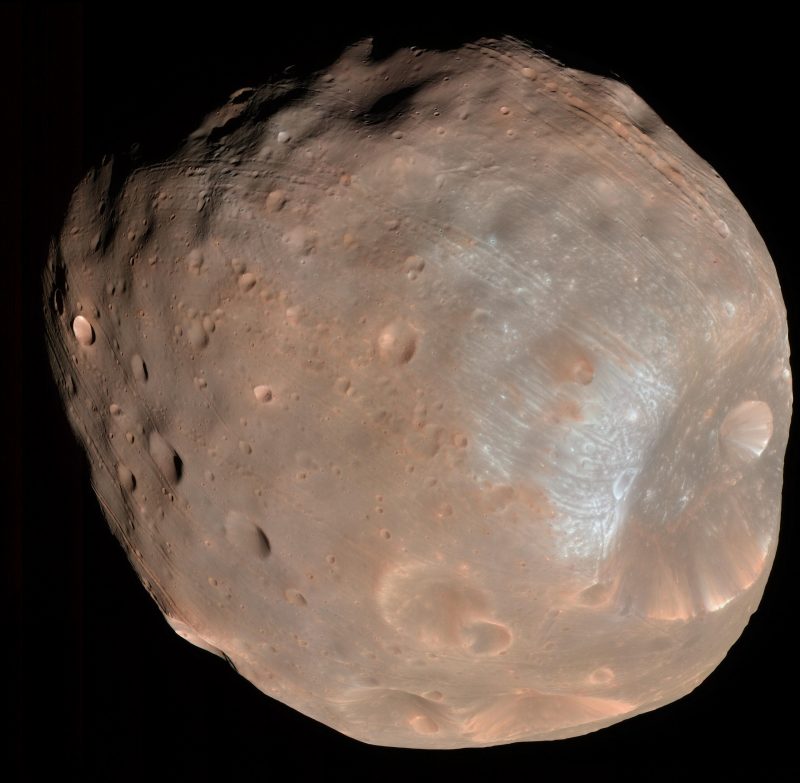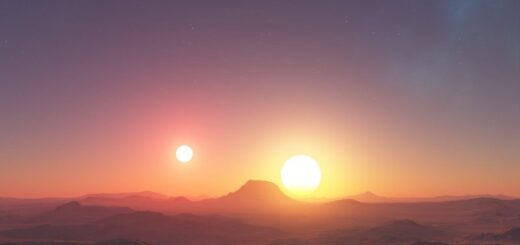Mars Atmosphere Shedding Charged Particles Onto Phobos?

A new study suggests that Mars’ larger moon Phobos orbits through a stream of charged particles flowing off the planet’s atmosphere. The findings, published February 1, 2021, in the peer-reviewed journal Nature Geoscience, suggest that the ions of oxygen, carbon, nitrogen, and argon charged particles smashing into Phobos have been accumulating on the moon’s surface for billions of years. The researchers say analysis of Phobos’ soil could provide important new details about the history of both worlds.
Blurry, irregular orange ball lighted from the left on a blurry blue background.
Phobos as observed by the MAVEN orbiter’s Imaging Ultraviolet Spectrograph. Orange shows mid-ultraviolet sunlight reflected from the surface of Phobos, exposing the moon’s irregular shape and many craters. Blue shows far ultraviolet light, which is scattered off of hydrogen gas in the extended upper atmosphere of Mars. Image via CU/ LASP/ NASA.
EarthSky lunar calendars show the moon phase for every day in 2021. Only a few left. Get one while you can!
For several decades, scientists have been studying Mars by examining the planet with orbiters, landers and rovers. In fact, there are currently 3 missions slated to arrive at Mars this month (February 2021), including NASA’s Perseverance, the United Arab Emirates’ first-ever interplanetary mission, called Hope, and China’s first Mars exploration mission, called Tianwen-1. The authors of the new study, researchers at University of California’s Space Sciences Laboratory, say there might be an additional way to learn about the red planet: by studying the surface of Phobos, one of Mars’ two moons (the other is called Deimos). The scientists say that analysis of the soil on the surface of this small potato-shaped moon could reveal important clues about Mars’ atmosphere and history.
Since Phobos, like the smaller moon Deimos, is a small rocky body completely separate from Mars itself, how can it tell us anything about Mars’ atmosphere? The answer is simply that many charged atoms and molecules – such as oxygen, carbon, nitrogen and argon – escape from and flow off the thin Martian atmosphere into space. Some of these charged particles – called ions – ultimately collide with Phobos. Scientists say that they could be preserved on Phobos’ surface. Lead author Quentin Nénon said in a statement:
We knew that Mars lost its atmosphere to space, and now we know that some of it ended up on Phobos.
If some of those particles could be collected and studied in labs, they could provide important details about Mars’ atmosphere and how it has evolved and is gradually being lost to space.
Since Phobos is tidally locked to Mars, meaning that the same side of the moon always faces the planet, the near side of Phobos, facing Mars, has been bombarded by Martian ions for billions of years, about 20 to 100 times more so than its far side. Nénon said:
With a sample from the near side, we could see an archive of the past atmosphere of Mars in the shallow layers of grain, while deeper in the grain we could see the primitive composition of Phobos.
Nénon and his team made this assessment after analyzing data from NASA’s Mars Atmosphere and Volatile EvolutioN (MAVEN) orbiter. MAVEN has been studying the Martian atmosphere for over six years and, during its primary mission, crossed the orbit of Phobos five time each day. The researchers decided to use those measurements to learn more about Phobos itself.
MAVEN’s Suprathermal and Thermal Ion Composition instrument (STATIC) was used to study the Martian ions in Phobos’ orbit, by measuring the kinetic energy and velocity of incoming particles. That, in turn, allowed scientists to measure their mass. Lower-mass ions came from the sun, but heavier-mass ones originated from Mars. The researchers estimated that those ions could penetrate several hundred nanometers (nm) into the soil on Phobos, about 250 times less than the general width of a human hair. One nanometer is one-billionth of a meter. According to co-author Andrew Poppe:
What Quentin has done is take investigations we’ve done at the moon and at other moons of the solar system and applied the same methods to Phobos for the first time.
Serious young man with NASA logo behind him.
Quentin Nénon at the University of California, Berkeley, lead author of the new study. Image via SSERVI.
Studying particles from Mars on its moons is also ideal for the simple reason that there is no wind or water to alter or destroy them. They are still in an untouched, pristine state of preservation. It’s the same for particles from Earth that have landed on our own moon. Poppe said:
What we’ve seen in Apollo samples is that the moon has been patiently recording individual atoms coming from the sun and from Earth. It’s a really cool historical record.
In much the same way as with Mars, scientists think that obtaining more samples from our moon’s surface will help them better understand not only the history and geology of our own natural satellite, but also Earth’s ancient atmosphere and early magnetic field.
The idea for looking for charged Martian particles on Phobos came about over coffee one day at the lab when there was no internet service, Poppe recounted:
I was forced to talk to my colleagues over coffee because we had nothing better to do.
The question came up as to whether Phobos could be subjected to Martian ions like Earth’s moon is subjected to them from Earth. Poppe asked:
Do you guys see any evidence of this?
Satellite with two large solar panels above a reddish planet with craters on its surface.
Artist’s concept of MAVEN in orbit around Mars. The new findings are based on analysis of data sent by MAVEN back to Earth. Image via NASA/ Goddard Space Flight Center.
It turned out that this was something nobody had looked at much, if at all. When Nénon joined the Space Science Laboratory, he made a point of going through the data from MAVEN, and found that there was indeed evidence for similar charged particles being transferred from Mars to Phobos. As he surmised:
So hopefully this finding will have an impact on the scientific activities of the MMX mission.
The Japan Aerospace Exploration Agency is now preparing to send the Martian Moons Exploration (MMX) probe in 2024 to visit Phobos. For the first time, samples will be taken directly from the surface of the small moon and brought back to Earth for further study. As Nénon noted, it might be beneficial, given the MAVEN findings, to land on the near side of Phobos. Collecting some of those particles could be invaluable for understanding the history of both Phobos and Mars.
Bottom line: Particles escaping from Mars’ atmosphere have been accumulating on the surface of the planet’s largest moon Phobos for billions of years. They could provide important new details about the history of both worlds.



 Creators of mankind
Creators of mankind Description of “Tall white aliens”
Description of “Tall white aliens” Where they came from?
Where they came from? About hostile civilizations
About hostile civilizations The war for the Earth
The war for the Earth “Tall white aliens” about eternal life
“Tall white aliens” about eternal life Video: “Nordic aliens”
Video: “Nordic aliens” Aliens
Aliens Alien encounters
Alien encounters The aliens base
The aliens base UFO
UFO Technology UFO
Technology UFO Underground civilization
Underground civilization Ancient alien artifacts
Ancient alien artifacts Military and UFO
Military and UFO Mysteries and hypotheses
Mysteries and hypotheses Scientific facts
Scientific facts


















